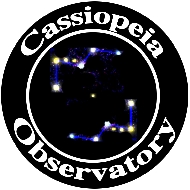
ASTROPHOTOGRAPHY WITH MX-1 TELESCOPE ADAPTER FOR APPLE iPHONE
Last updated: 23 March 2011
My initial iPhone astrophotography tests using the MX-1 were with the Meade 8" LX200-ACF that is permanently set up in my SkyShed POD "Cassiopeia Observatory". I also used one of my Meade ETX telescopes, as well as the 8" telescope, during additional testing. (I plan to do additional testing with my other ETX telescopes.) All of the astrophotos on this page were done with an Apple iPhone 4 (AT&T model) using the MX-1. If you haven't already read my review of the Magnilux MX-1 Telescope Adapter for Apple iPhone, click this link. Unless otherwise noted, the images are unedited to show exactly what anyone can do with the iPhone and MX-1. All images are full iPhone 4 frame but are reduced in size for web page presentation. The original iPhone 4 photos are much larger, making them suitable for cropping and editing to show just the object being imaged. The images are shown in the order that I captured them.
My first target was the gibbous moon on 14 March 2011. These images show the moon as photographed using the iPhone "Camera" app. The telescope and eyepiece used is noted for each image.
8" LX200-ACF, Meade Series 4000 26mm eyepiece

8" LX200-ACF, Meade Series 4000 26mm eyepiece

The two images above were the first ones I took using the MX-1. I didn't do any adjustments to try to improve the eyepiece focal plane position (as I was racing the clouds). But they do show what type of image of the moon can be quickly captured by the iPhone when using an afocal adapter like the MX-1.
This next set of moon images did have some adjustments made to better frame the focal plane.
8" LX200-ACF, Meade Series 4000 26mm eyepiece + Meade Series 5000 3X TeleXtender

8" LX200-ACF, Meade Series 4000 26mm eyepiece + Meade Series 5000 3X TeleXtender

8" LX200-ACF, Meade Series 4000 26mm eyepiece + Meade Series 5000 3X TeleXtender

8" LX200-ACF, Meade Series 4000 9.7mm eyepiece

8" LX200-ACF, Meade Series 4000 9.7mm eyepiece
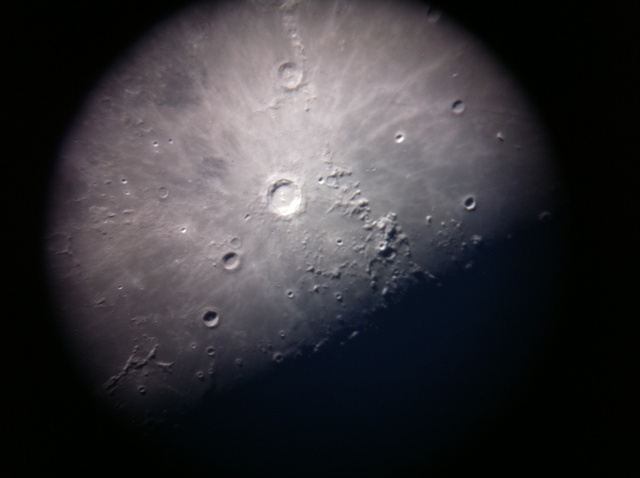
8" LX200-ACF, Meade Series 4000 9.7mm eyepiece

The Meade Series 5000 5.5mm eyepiece used for this next photo, has a very short eye relief. I was unable to get the FOV to match up with the iPhone.
8" LX200-ACF, Meade Series 5000 5.5mm eyepiece

Since I was unable to image the entire moon with the 26mm eyepiece on the 8" LX200-ACF, I switched to a 40mm eyepiece. This eyepiece has a large barrel, but the mid-sized clamp from the MX-1 was able to fit it. I used this same clamp for all the iPhone images on the LX200 and ETX telescopes.
8" LX200-ACF, 40mm eyepiece

Now that I had some brief experience with using the MX-1, I switched back to the 26mm eyepiece to improve the focal plane positioning. But I still couldn't quite capture the entire moon.
8" LX200-ACF, Meade Series 4000 26mm eyepiece

I then set up my Meade ETX-70AT telescope and attached the MX-1, iPhone 4, and 26mm eyepiece. Unfortunately, the bright moon overexposed with the "Camera" app at this low magnification (14X). I added a moon filter to the 26mm eyepiece but the image still overexposed. I switched to a Meade 9mm eyepiece (39X) and using the moon filter, I was able to get a reasonably good image.
ETX-70AT, Meade 9mm eyepiece + moon filter

For this next ETX-70AT iPhone 4 image, I used the "Camera" app digital zoom to magnify the moon.
ETX-70AT, Meade 9mm eyepiece + moon filter, digital zoom

At this point, the clouds covered the moon and I ended my initial MX-1 tests. I then began waiting for the next clear opportunity.
Finally, on 17 March, the skies were clear. I did some more MX-1 iPhone 4 astrophotography.
Jupiter (low in western sky), 8" LX200-ACF, 9mm eyepiece + moon filter
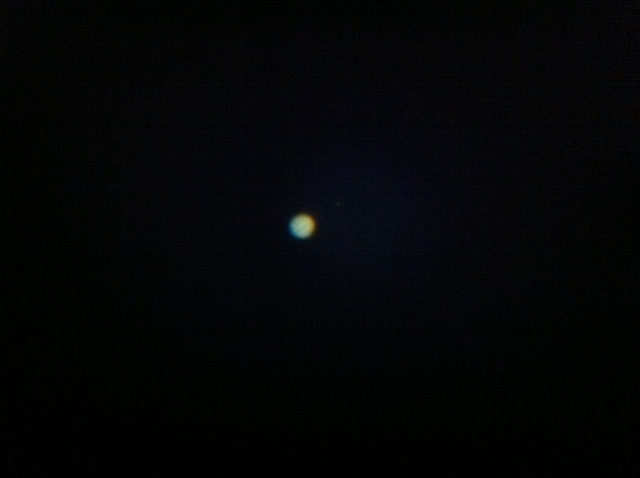
Mercury (low in western sky), 8" LX200-ACF, 9mm eyepiece + moon filter, digital zoom

To confirm Mercury's phase seen in the photo, compare this graphic from the US Naval Observatory depicting Mercury at the same time as the photograph:

I then took this photograph of Jupiter and Mercury as seen in the 7x50 binoculars (piggyback on the telescope and tilted). This image has been edited to brighten it.
Jupiter (left) and Mercury (right), 7x50 binoculars

I also did some more lunar astrophotography with the iPhone 4, without and with a Meade #126 2X Barlow Lens:
8" LX200-ACF, 9mm eyepiece + moon filter

8" LX200-ACF, 9mm eyepiece + moon filter

8" LX200-ACF, 9mm eyepiece + moon filter
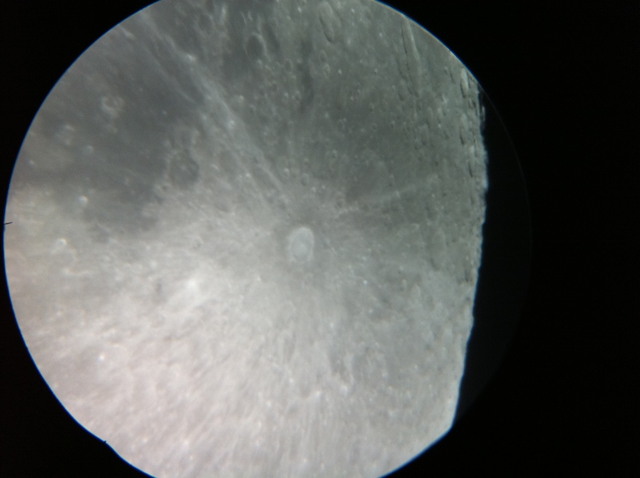
8" LX200-ACF, 9mm eyepiece + moon filter + 2X Barlow Lens
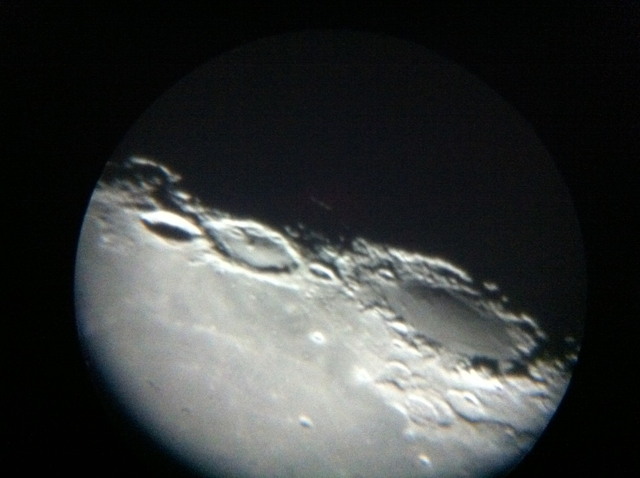
8" LX200-ACF, 9mm eyepiece + moon filter + 2X Barlow Lens

8" LX200-ACF, 9mm eyepiece + moon filter + 2X Barlow Lens

Saturn is always a popular astrophotograph target. And yes, the iPhone can image it.
Saturn, 8" LX200-ACF, 9mm eyepiece + moon filter

Saturn, 8" LX200-ACF, 9mm eyepiece + moon filter, digital zoom

Saturn, 8" LX200-ACF, 9mm eyepiece + 2X Barlow Lens
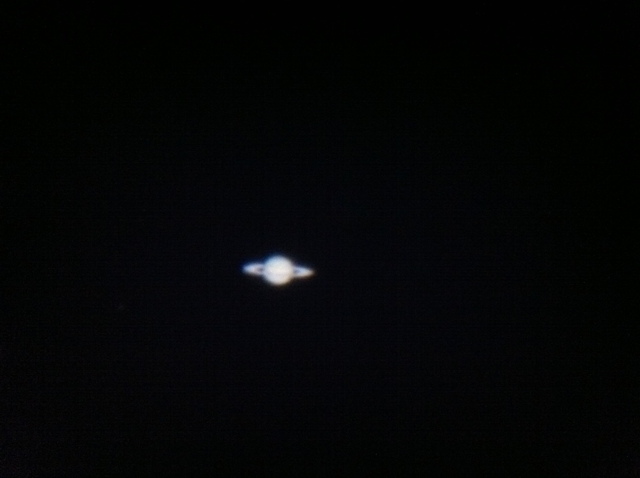
Saturn, 8" LX200-ACF, 9mm eyepiece + 2X Barlow Lens, digital zoom

I did a 10 second video recording of Saturn using the iPhone 4 with the 9mm eyepiece + 2X Barlow Lens. Click the image below to view the video.
As you can see, the iPhone with MX-1 afocal adapter works really well on the moon and planets.
How about the sun? I used both my 8" LX200-ACF (with a Thousand Oaks white light solar filter) and the Coronado Personal Solar Telescope (PST) for the images. Both images have had some editing done. A small sunspot group is visible in the first image. Two large prominences and one small prominence are visible in the second image, at 10 o'clock, 5 o'clock, and 7 o'clock.
8" LX200-ACF, 26mm eyepiece + moon filter, digital zoom

PST, 9mm eyepiece

The sun is a challenging object for the iPhone's "Camera" app. I tried various eyepieces on both the LX200-ACF and PST, and could either not get a good exposure or a good FOV.
A nightscope can even be used for some types of astrophotography. Here is part of the constellation of Orion as seen through some clouds that were illuminated by a nearly full moon:
Orion, Night Owl Optics nightscope

On the night of 19 March 2011, I captured the so-called "Super Moon" after it rose using a zoom spotting scope. The image has been slightly edited.
Carton Zoom 13-40x40mm telescope
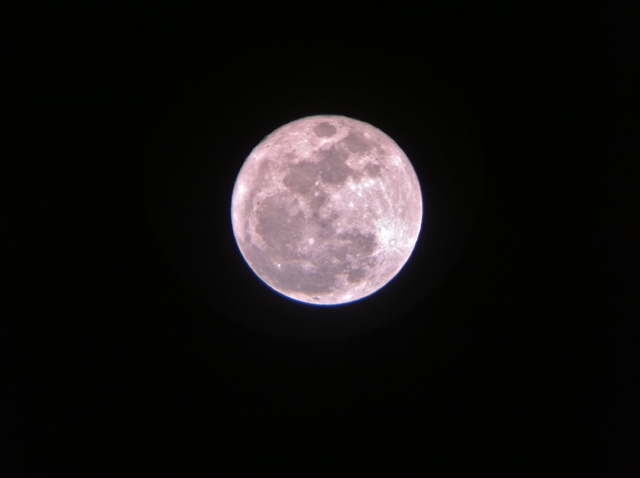
What about stars and deep sky objects (DSOs)? I have previously imaged stars and M42, the Great Nebula in Orion, with an iPhone, but I did want to try it using the MX-1. This first image shows Orion's "Belt" and was taken with an iPhone 4 attached to 7x50 binoculars (mounted piggyback on the telescope). For this "long" exposure I used an iOS app called "Slow Shutter". This app takes multiple exposures and then "stacks" them in the iPhone. The exposure setting was 30 seconds, EV +2.0. The image has been edited to reduce the "scan lines" that result from the "long" exposure. Several stars and even M42 can be seen.
Orion's "Belt" 7x50 binoculars

Using the iPhone on binoculars at night was a challenge. The dark sky made getting the optical axes aligned very difficult. I was finally able to see a star on the iPhone screen, and after some framing test exposures, I got the photograph above.
This image of M42 was taken afocally through the 8" telescope using a focal reducer and 26mm eyepiece. Slow Shutter was used for the exposure with settings of 30 seconds, EV +2.0, black&white. Again, some editing has been done to reduce the scan lines. The brighter portion of M42 can be seen.
M42, 8" LX200-ACF, 26mm eyepiece + focal reducer

MX-1 iPhone Afocal Adapter review
Go to the ETX site.
Go to the Cassiopeia Observatory site.